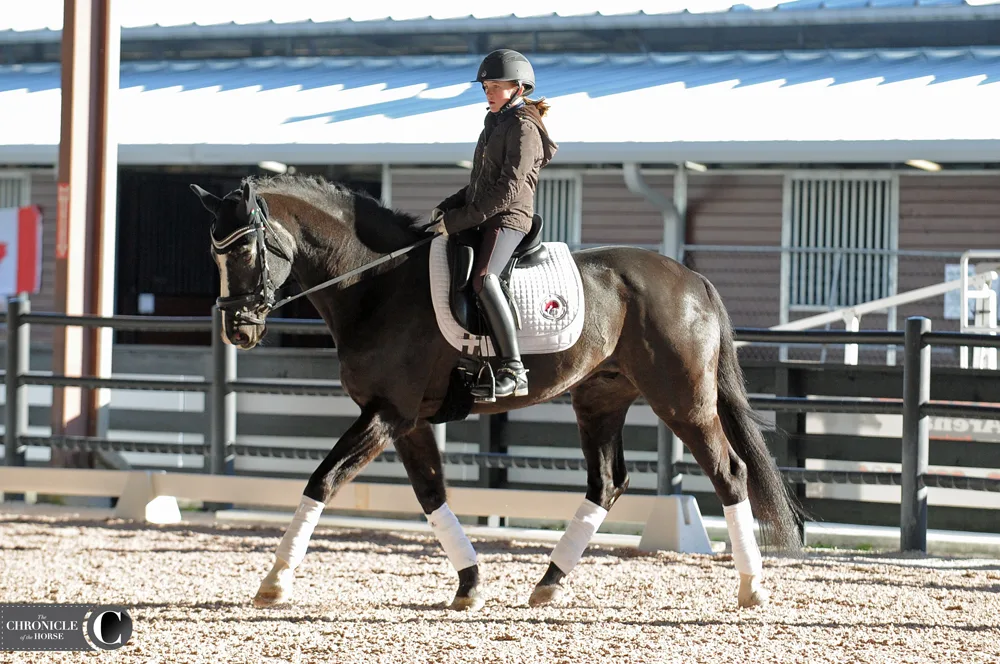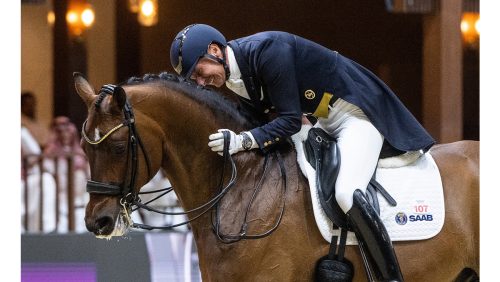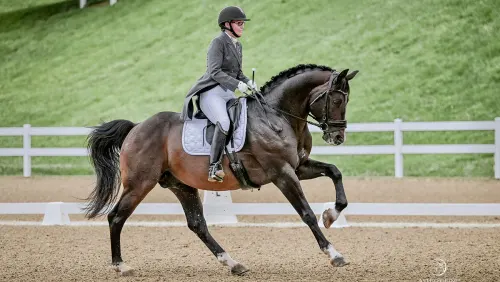Wellington, Fla.—Jan. 4
There were plenty of pearls of wisdom to pick up from some of the best dressage riders in the country at the Robert Dover HorseMastership Clinic on Thursday. From energizing the quiet gelding to calming the spooky mare and everything in between, Olympic veterans Robert Dover and Jan Ebeling had plenty of advice for their young students.
Livening Up The Quiet Horse
Ebeling helped 11-year-old Kasey Denny get her quiet schoolmaster a little more animated with a couple of different exercises.
“The mistake I see people make with a quieter horse is they just start doing all this kicking and spurring and pushing with the leg,” Ebeling said. His goal was to help Denny get her horse to a point where she didn’t need to constantly push him forward. Denny’s horse could also get heavy in the bridle, so to start Ebeling had her trot around the ring and across the diagonals while integrating three or four steps of a quicker medium trot.
“You need to take, put your leg on and then get light, and the getting light is important,” Ebeling said. “If you just pull and pull he’s going to get heavy and sluggish.”
Ebeling highlighted the difference between being light in the rein and throwing away the contact.
“Close your fingers and push to go to trot, and then get light rather than pushing and then letting everything go,” Ebeling said.
ADVERTISEMENT
The next exercise Ebeling had Denny do was a 10-meter circle in the corners of the ring followed by a shoulder-in down the long side. Ebeling also had Denny do walk-canter transitions on a circle
“With a quiet horse you want to do exercises where they have to go and come back,” Ebeling explained.
Riding The Spook
Dover helped Kaitlyn Blythe get her mare past some spooky areas in the arena. “Bend away from the camera, away from what she’s spooking at, and then leg-yield back toward the camera, and go by that camera almost in a shoulder-in,” Dover said. “You want to really push through the spooky spots but think she’s got to come back and settle in that moment. She can’t rush through it—bring her back like you’re going to walk.”
For five minutes or so Dover wanted Blythe to stay on a circle near the spooky camera and desensitize her, but then Dover sent Blythe around the arena in different combinations of movements.
“Another part of this is not doing the same thing for too long; you need to keep her mind thinking about your leg and where you’re sending her,” Dover said. “She needs to think about going around dancing with you like a good dance partner, so repackage her and go forward.”
Using The Whip
Dover reminded a young rider on the proper use of her dressage whip. “The whip is enhancing your foot, so don’t hit a horse on the butt or the haunch; use it where you would use your leg,” Dover said. “You use it until she’s a little afraid of the consequence of not going forward from your leg. Not that she’s afraid of you but of the consequence of not listening to the aid.”
ADVERTISEMENT
Rewarding The Horse
Even more important than the consequence of not listening to the aid is the reward for following it—Dover disciplined riders to use their voice more often than pats. “You have to be talking to her when she does something good, so she knows. She doesn’t know this way is better unless you tell her,” Dover said. “And it’s not your arms changing to say ‘good job.’ It’s your voice that tells her she is good.”
Collection In The Extension And Vice Versa
“When you’re in a collected trot that is supposed to be the collection of a horse that is desiring to be in the extended trot,” Dover said. “The reason that these great horses like [Verdades] and Valegro and Totilas look like they’re dancing so effortlessly is when they are in the collected gait they are desiring to be in the extended gait, and when they’re in the extended gait they are collected in that extension. At the end of the day, it’s all about if the horse is committed to going forward.”
Go Hollywood
It’s important to Dover that riders not only think of the mechanics of good riding—he wants them to use their imagination to picture what their ride should look like. “You have to see a movie in your mind as you’re going around the ring,” Dover said. “You have to have that inner vision, see your horses trotting like [Verdades] down the diagonal.”
Last But Not Least
Dover chastised a student who forgot something very important for the end of his ride. “A good trainer always has sugar in their pocket!” (Sugar is better than mints or colored treats because it doesn’t change the color of the horse’s saliva and foam.)
Read more of the COTH coverage from the Robert Dover Masterclass.

















